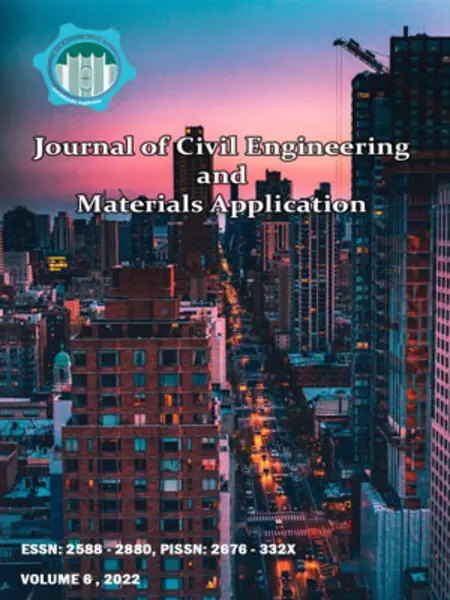-
simulated c3a effects on the chloride binding in portland cement with nacl and cacl2 cations
جزئیات بیشتر مقاله- تاریخ ارائه: 1401/03/24
- تاریخ انتشار در تی پی بین: 1401/03/24
- تعداد بازدید: 359
- تعداد پرسش و پاسخ ها: 0
- شماره تماس ژورنال: 02166176087
simulated c3a effects on the chloride binding in portland cement with nacl and cacl2 cations
c3a contents of portland cement have a significant role in chloride ion binding in chloride-contaminated environments. cations released due to nacl and cacl2 in chloride environments are the most common and aggressive agents. in this research, various simulated pure c3a were made using calcium hydroxide and aluminum hydroxide, including 5%, 8%, 10%, and 12%. moreover, the different concentrations of sodium and calcium cations in nacl and cacl2 in the simulated portland cement paste were added the bonding performances were investigated.
x-ray diffraction (xrd) of prepared c3a samples identified for major phases of specimens. thermo-gravimetry analysis (tga) was used to quantify the simulated c3a. standard test methods, including astm c1152 and astm c1218, were utilized to measure the acid-soluble and water-soluble chloride in prepared specimens, respectively. the results showed that the amount of acid-soluble and water-soluble chloride for nacl and cacl2 cations decreased with an increase of the c3a, which indicates a better chloride ion binding potential.
moreover, it was concluded that cacl2 cations have more chloride binding capacity than nacl. for calcium cations in cacl2, the increase of c3a is distinguished in water-soluble chloride in comparison with nacl cations. then, in areas contaminated with nacl ions, it is recommendable to use more c3a content in the portland cement.
حوزه های تحت پوشش ژورنال
مقالات جدیدترین رویدادها
-
استفاده از تحلیل اهمیت-عملکرد در ارائه الگوی مدیریت خلاقیت سازمانی و ارائه راهکار جهت بهبود
-
بررسی تاثیر ارزش وجوه نقد مازاد بر ساختار سرمایه شرکت های پذیرفته شده در بورس اوراق بهادار تهران
-
بررسی تأثیر سطح افشای ریسک بر قرارداد بدهی شرکت های پذیرفته شده در بورس اوراق بهادار تهران
-
بررسی تأثیر رتبه بندی اعتباری مبتنی بر مدل امتیاز بازار نوظهور بر نقد شوندگی سهام با تأکید بر خصوصی سازی شرکت ها
-
تأثیر آمیخته بازاریابی پوشاک ایرانی بر تصویر ذهنی مشتری پوشاک ایرانی (هاکوپیان)
-
بررسی تغییرات الکتروکوکلئوگرافی و پاسخهای شنیداری ساقه مغز در 100 بیمار مبتلا به منیر در بیمارستان رسول اکرم (ص) 1379-1377
-
تأثیر هوش هیجانی، ویژگی های شخصیتی و روابط بر تمایل به تغییر رفتار مصرف کننده در صنعت ورزش
-
واکاوی وضعیت آموزش مهارت های اساسی زندگی در پایه ششم ابتدایی از دیدگاه معلمان و متخصصان
-
بازشناسی راهکارهای طراحی مطابق با الگوهای پایداری محیطی در معماری بافت قدیم بوشهر
-
بررسی آزمایشگاهی رفتار شمع پافیلی تحت بارهای کششی مایل در خاک ماسه ای
مقالات جدیدترین ژورنال ها
-
مدیریت و بررسی افسردگی دانش آموزان دختر مقطع متوسطه دوم در دروان کرونا در شهرستان دزفول
-
مدیریت و بررسی خرد سیاسی در اندیشه ی فردوسی در ادب ایران
-
واکاوی و مدیریت توصیفی قلمدان(جاکلیدی)ضریح در موزه آستان قدس رضوی
-
بررسی تاثیر خلاقیت، دانش و انگیزه کارکنان بر پیشنهادات نوآورانه کارکنان ( مورد مطالعه: هتل های 3 و 4 ستاره استان کرمان)
-
بررسی تاثیر کیفیت سیستم های اطلاعاتی بر تصمیم گیری موفق در شرکتهای تولیدی استان اصفهان (مورد مطالعه: مدیران شرکتهای تولیدی استان اصفهان)
-
پیش بینی انسجام و کارکردهای خانوادگی در زوج ها، براساس عمل به باورهای دین
-
جرم شناسی اطفال و ارزیابی شخصیت اطفال بزهکار
-
تجلی مضامین دینی در نقوش انسانی ظروف سفالین دوره سلجوقی
-
determination of organochlorine and organophosphorous pesticide residues in irrigated water from gubi, waya dams and gudum fulani irrigation sites in bauchi lga, bauchi state,nigeria using composite sampling
-
investigation into the effect of bed stiffness on seismic performance of concrete gravity dam under far- and near- field earthquakes


سوال خود را در مورد این مقاله مطرح نمایید :